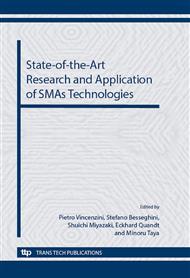p.69
p.75
p.81
p.87
p.92
p.103
p.113
p.119
p.125
Studies on Internal Friction of a High Temperature Cu-Al-Mn-Zn Shape Memory Alloy
Abstract:
Materials with high damping capacity for quelling noise and vibration in engineering structures have drawn increasing attention in recent times. Among the different materials that have been attempted so far, shape memory alloys (SMAs) have shown much promise since they exhibit much higher damping due to the occurrence of a thermoelastic martensitic transformation in them. Among the SMAs it is copper-based SMAs that have proved more attractive compared to Ni-Ti SMAs because of their lower cost, higher damping and better machining characteristics. In the present work, therefore, the damping properties of a Cu-Al-Mn-Zn alloy, a potential high damping material for high temperature turbomachinery rotor blades, are investigated. The internal friction was studied using a dynamic mechanical analyzer over a range of temperatures (25-300°C), frequencies (0.5-10Hz) and strain amplitudes (5×10-6 and 10-4). The analysis of the results reveals that the damping properties are more sensitive to variation in frequency and strain amplitude, pointing to the suitability of the material for the intended application. The results are presented and discussed in the paper.
Info:
Periodical:
Pages:
125-132
Citation:
Online since:
September 2012
Authors:
Price:
Сopyright:
© 2013 Trans Tech Publications Ltd. All Rights Reserved
Share:
Citation:


